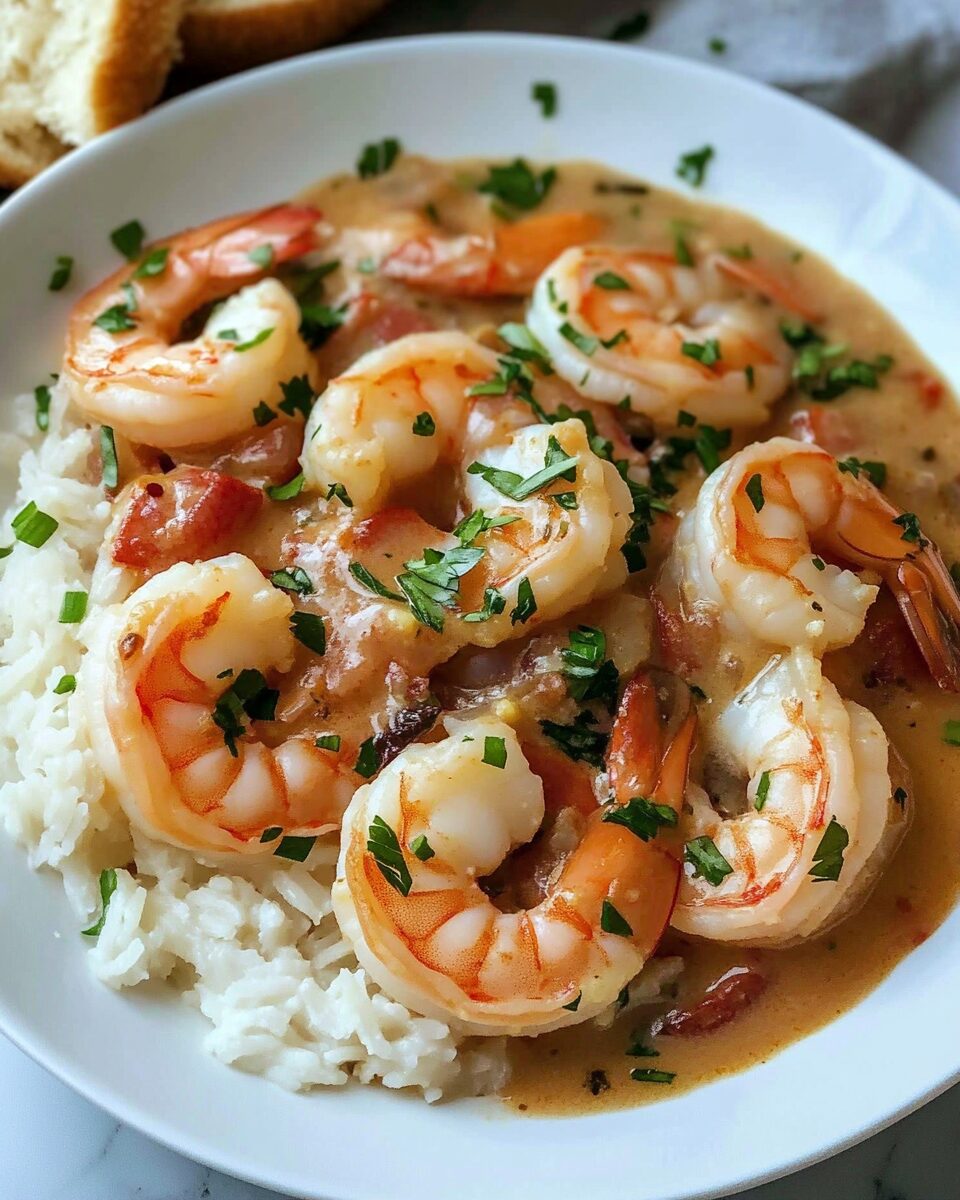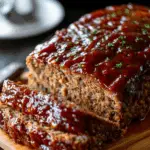Shrimp Étouffée is a quintessential Louisiana dish that brings together the rich flavors of the South. The combination of tender shrimp, a flavorful roux, and the “holy trinity” of onions, celery, and bell peppers creates a comforting and satisfying meal. Served over a bed of rice, this dish is perfect for a cozy dinner at home or impressing guests at a gathering.
The beauty of Shrimp Étouffée lies in its versatility. While the classic recipe is a favorite, feel free to experiment with different proteins like crawfish, crab, or even chicken. The base sauce remains the same, ensuring a delicious and flavorful experience every time. Whether you’re a seasoned cook or a beginner, this dish is sure to become a staple in your culinary repertoire.
Full Recipe
Ingredients:
-
For the Shrimp:
-
1½ lbs shrimp (peeled and deveined)
-
1 tablespoon Cajun seasoning
-
1 tablespoon olive oil
-
-
For the Roux:
-
⅔ stick unsalted butter (or 5 tablespoons + 1 teaspoon)
-
⅓ cup all-purpose flour
-
2 cups chicken broth (or 500 ml)
-
-
For the Holy Trinity:
-
1 medium onion (diced)
-
½ cup green bell pepper (diced)
-
1-2 stalks celery (chopped)
-
-
Spices and Seasonings:
-
1 teaspoon dried thyme
-
3 teaspoons minced garlic
-
2 bay leaves
-
1 tablespoon Worcestershire sauce
-
1 cup fresh tomato (diced)
-
1 tablespoon Creole or Cajun seasoning
-
Salt and pepper to taste
-
-
Garnishes:
-
¼ cup green onions (thinly sliced)
-
¼ cup parsley (chopped)
-
½ lemon (juiced)
-
Directions:
-
Spice it Up: In a small bowl, combine paprika, thyme, oregano, cayenne, garlic powder, onion powder, white pepper, and black pepper to create a spice blend.
-
Prep the Shrimp: Drain and pat dry the shrimp. Toss them in the prepared spice blend to coat evenly.
-
Shrimp Sizzle: Heat olive oil in a large skillet over medium-high heat. Add the seasoned shrimp and cook for 1 minute on each side until just pink. Remove shrimp from the skillet and set aside.
-
Stock it Up: While the shrimp rest, strain any released juices into the chicken broth to make a total of 2 cups of broth.
-
Building Flavor: In the same skillet, melt butter over medium heat. Add diced onion, bell pepper, and chopped celery (the Holy Trinity) and sauté until softened. Sprinkle in 1 teaspoon of Cajun/Creole seasoning.
-
Roux Time: Stir in the flour and cook, stirring constantly, until the mixture turns a medium brown color (about 5-7 minutes). Add diced tomatoes and cook for an additional 2-3 minutes. Gradually whisk in the prepared chicken broth mixture until smooth.
-
Simmer Down: Bring the mixture to a simmer and let it thicken for a few minutes. Add Worcestershire sauce and hot sauce to taste. Season with salt and pepper.
-
Shrimp Reunion: Return the cooked shrimp to the skillet and simmer for 1-2 minutes until heated through.
-
Finishing Touch: Garnish with sliced green onions, chopped parsley, and a squeeze of lemon juice. Serve over a bed of rice.
Prep Time: 10 minutes | Cooking Time: 30 minutes | Total Time: 40 minutes
Kcal: 260 kcal | Servings: 4 servings
A Taste of Louisiana: The Origins of Shrimp Étouffée
Shrimp Étouffée is more than just a meal—it’s a celebration of Southern heritage and culinary tradition. Born in the heart of Louisiana, this dish showcases the soulful fusion of French, African, and Spanish influences that define Creole and Cajun cuisine. The word “étouffée” is French for “smothered,” referring to the method of simmering ingredients in a thick, flavorful sauce, typically served over rice. While many associate Étouffée with crawfish, shrimp has become an equally beloved alternative, particularly in coastal areas where fresh seafood is abundant.
Historically, Shrimp Étouffée started as a humble, home-cooked meal prepared with ingredients on hand—shrimp freshly caught from the bayous, vegetables from the garden, and a few pantry staples. Over time, it became a menu staple in restaurants throughout the South and a symbol of Louisiana comfort food.
What Sets Shrimp Étouffée Apart
What makes Shrimp Étouffée stand out among seafood dishes is its signature roux—a slowly cooked blend of fat and flour that acts as the flavor base of the dish. Unlike many other stews or gravies, this roux is cooked until it reaches a rich, caramel brown hue, giving the final dish a deep, nutty taste. When combined with the “holy trinity” of Cajun cuisine—onions, bell peppers, and celery—the result is a sauce that is both robust and layered.
Another hallmark of this dish is its seasoning. Creole and Cajun blends add a bold kick, balancing paprika, cayenne, garlic powder, and herbs. The sauce has just the right amount of heat to warm your palate without overwhelming it. Shrimp, with its tender texture and mild flavor, absorbs this spicy sauce beautifully, making each bite rich, zesty, and satisfying.
Creole vs. Cajun: A Subtle but Delicious Difference
One of the most fascinating things about Shrimp Étouffée is how it reflects the two dominant cooking styles of Louisiana: Creole and Cajun. While these terms are often used interchangeably, they carry distinct cultural and culinary differences. Creole cuisine originated in New Orleans and was heavily influenced by European settlers. It’s known for its use of tomatoes, butter, and a wide variety of spices. Cajun cuisine, on the other hand, developed in the rural areas and tends to be spicier and more rustic.
In a Creole-style Shrimp Étouffée, you’ll typically find tomatoes added to the sauce, which adds a touch of sweetness and depth. Cajun versions are more likely to omit tomatoes in favor of a richer, darker roux. Both are equally delicious, and your personal preference may depend on whether you like a slightly tangier or more savory sauce.
Why This Dish is Perfect for Any Occasion
Shrimp Étouffée is a flexible dish that’s just as suited to a cozy night at home as it is to a festive gathering. It’s warm and hearty, making it ideal for colder months, yet light enough to enjoy year-round. It’s also an excellent option when entertaining, as it can be prepared in advance and easily doubled to serve a crowd.
Thanks to its impressive presentation—glistening shrimp nestled in a spicy, thick sauce over a bed of steaming rice—it looks as good as it tastes. Serve it with a side of French bread to soak up every drop of sauce, and maybe a simple green salad for contrast, and you’ve got a complete, satisfying meal.
Health and Nutrition Insights
Although often seen as a decadent comfort food, Shrimp Étouffée can be surprisingly nutritious with a few small tweaks. Shrimp is naturally low in calories and fat while being high in protein and essential nutrients like selenium, B12, and omega-3 fatty acids. Using homemade broth reduces sodium, and swapping butter for olive oil or using a lighter roux can make the dish more heart-healthy.
Additionally, if you’re catering to dietary needs, this dish is easy to adapt. It can be made gluten-free with rice flour or another alternative in the roux. For a dairy-free version, avoid butter or use plant-based substitutes. And if you’re looking to reduce carbs, you can serve it over cauliflower rice or zucchini noodles.
Tips for Making the Perfect Shrimp Étouffée
Getting Shrimp Étouffée just right is all about building layers of flavor. Here are a few tips that make a big difference:
-
Use fresh or high-quality shrimp: While frozen shrimp can work in a pinch, fresh shrimp elevates the dish. Be sure to devein and peel them properly.
-
Cook the roux slowly and carefully: A burnt roux will ruin the flavor. Take your time to get it to that perfect medium-brown shade.
-
Don’t overcook the shrimp: Add them at the end of cooking to avoid a rubbery texture. Just a couple of minutes of simmering is all they need.
-
Season to your taste: Cajun and Creole seasoning blends vary widely. Taste as you go and adjust the heat level based on your preference.
-
Let it rest: Like many stews, this dish gets better after sitting for a while, allowing the flavors to meld beautifully.
Pairing Suggestions for a Full Louisiana Experience
Want to go all in on a Southern feast? Pair Shrimp Étouffée with:
-
Cornbread or buttermilk biscuits for a buttery side
-
Fried green tomatoes or okra for a tangy crunch
-
Sweet tea or a classic Sazerac cocktail for a true Louisiana touch
-
Bread pudding or pecan pie for dessert
This full spread brings the soul of the South to your table, creating a sensory journey through flavor and tradition.
Cultural Significance and Community Roots
In Louisiana, food isn’t just sustenance—it’s community. Dishes like Shrimp Étouffée are often served at family reunions, Sunday dinners, and festivals. It’s a recipe passed down through generations, sometimes with secret spices or personal touches unique to each household.
Making Étouffée isn’t just about the final product—it’s about the process: stirring the roux slowly while chatting with loved ones, tasting and tweaking the spice mix, and watching the sauce come together. That experience—the sharing of food and time—is what makes this dish so special in the hearts of many.
Conclusion
Shrimp Étouffée is a culinary gem that brings together rich history, bold flavor, and comforting familiarity in every bite. It’s a dish that tells a story—of family, of culture, of Louisiana’s vibrant food heritage. Whether you’re discovering it for the first time or returning to an old favorite, every spoonful offers warmth, satisfaction, and connection.
What makes Shrimp Étouffée truly remarkable is its ability to feel both indulgent and accessible. It invites you to slow down, savor, and share. So the next time you’re looking for a dish that’s as soul-satisfying as it is flavorful, let Shrimp Étouffée be your go-to. Cook it with intention, serve it with love, and enjoy a little piece of Louisiana no matter where you are.






